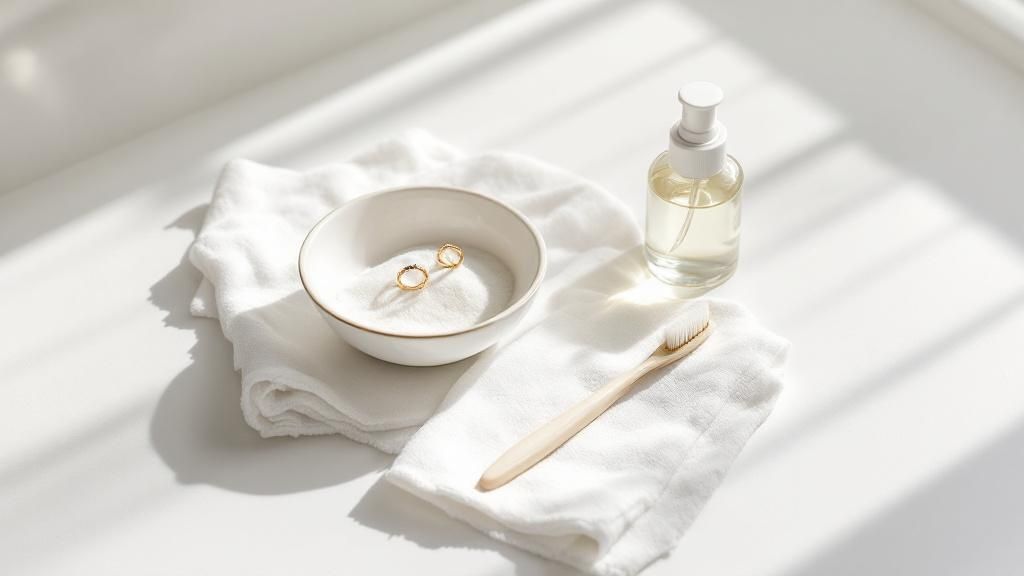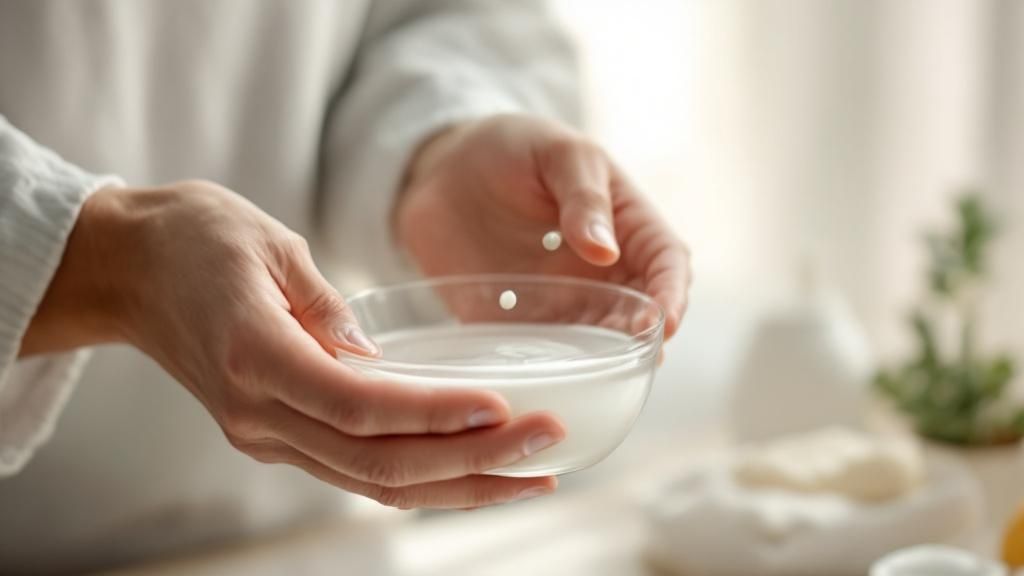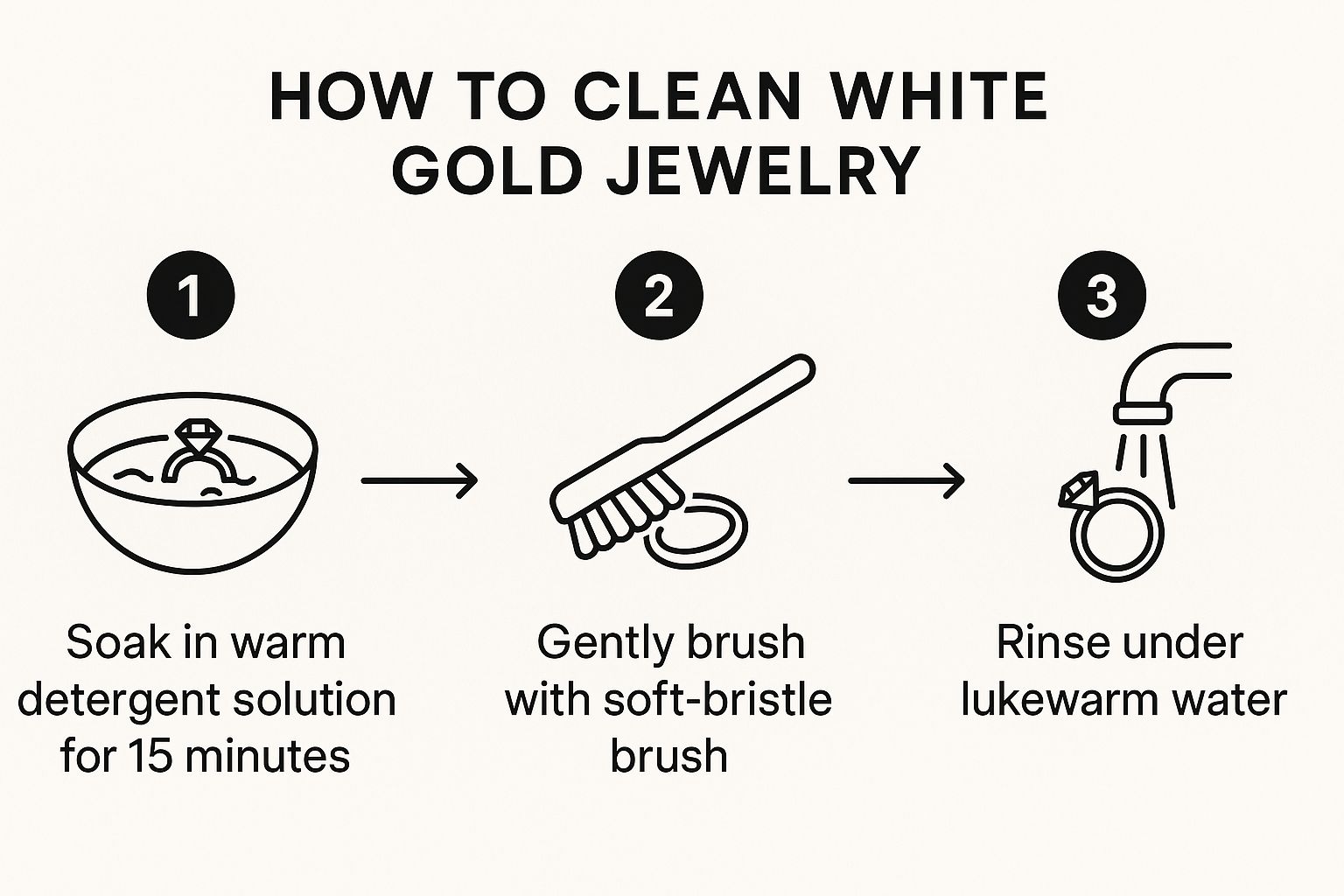How to Clean White Gold Jewellery: Restoring Its Sparkle
- Luke Zucco
- Aug 7
- 9 min read
It's always a little sad when you notice your favourite white gold ring or necklace has lost its brilliant shine. The good news? You can often bring that sparkle back yourself, right at home. The best place to start is with a simple, safe soak in some warm water mixed with a few drops of mild dish soap. This gentle bath is surprisingly effective at cutting through the daily grime without harming the metal's delicate finish.
Why Your White Gold Has Lost Its Sparkle

Before we get into the cleaning steps, it helps to know exactly what you’re dealing with. That stunning, silvery-white sheen you fell in love with isn't the natural colour of the gold alloy. It's actually a super-thin coating of rhodium that’s been electroplated onto the piece.
Over time, this rhodium plating gets hidden under a film of things your jewellery comes into contact with every single day. Just think about it:
Hand lotions and perfumes
Residue from soaps and shampoos
Your skin's natural oils
Everyday dust and dirt
This buildup acts like a dull film, preventing light from reflecting properly and making your cherished pieces look tired and lackluster. This is completely normal, especially for items like rings and bracelets that are constantly exposed to the elements.
The Role of Rhodium Plating
That rhodium plating does two important jobs: it gives the piece its desirable, bright-white colour and it adds a layer of protection to the slightly yellowish gold alloy beneath. But this plating is incredibly thin and delicate.
This is why using harsh chemicals or abrasive scrubbers is a huge no-no. They can easily wear away or even strip the rhodium right off, which is damage you can't undo at home.
The whole point of cleaning your white gold at home isn't to buff out scratches—it's to gently lift off the surface gunk. Regular, gentle maintenance is the key to preserving the rhodium plating and keeping your jewellery looking brilliant between professional cleanings.
Knowing this makes it clear why we're focusing on gentle, non-abrasive techniques. We're here to help you safely clear away that dulling film to reveal the beautiful sparkle underneath.
Your Gentle At-Home Cleaning Toolkit

Before you even think about cleaning your favourite white gold pieces, let’s get your supplies in order. Having the right tools on hand is the difference between a brilliant shine and a trip to the jeweller for repairs. The key here is to be gentle. You’re not scrubbing a pot; you’re carefully lifting away the daily grime from a delicate surface.
Luckily, you probably have everything you need right in your kitchen and bathroom.
What You'll Need
Think of this as putting together a little spa day kit for your jewellery. You only need a few simple, everyday items to get the job done right.
Here’s your shopping list:
A small bowl: Just needs to be big enough for your piece to be fully submerged.
Warm water: Make sure it’s just warm, not hot. Extreme heat can sometimes be risky for certain gemstone settings.
Mild dish soap: This is your secret weapon. I always recommend a simple, phosphate-free soap. Avoid anything with harsh degreasers or antibacterial additives.
An ultra-soft toothbrush: This is non-negotiable. It has to be incredibly soft to avoid scratching the rhodium plating. A baby toothbrush is perfect for this.
A soft, lint-free cloth: A microfibre cloth, like the kind you’d use for eyeglasses, is ideal for a streak-free, gentle dry.
Safe vs. Harmful Cleaning Agents for White Gold
Knowing what not to use is just as important as knowing what to use. To make it crystal clear, here’s a quick reference table.
Safe for White Gold | Avoid at All Costs |
|---|---|
Mild, phosphate-free dish soap | Bleach |
Warm water | Chlorine |
Professional jewellery cleaning solution | Ammonia |
Ultra-soft or baby toothbrushes | Abrasive toothpaste |
Soft, lint-free cloths (e.g., microfibre) | Baking soda |
Essentially, if it feels harsh or abrasive, it has no business being near your white gold.
Expert Tip: Steer clear of any household cleaners containing bleach, chlorine, or ammonia. These chemicals are far too aggressive for white gold's rhodium plating. Similarly, abrasive powders like baking soda or gritty substances like toothpaste will create micro-scratches, dulling the finish and eventually exposing the yellowish gold alloy underneath.
By sticking with this simple, gentle approach, you'll protect that beautiful rhodium finish, ensuring your white gold stays brilliant and sparkling for years. It's all about preserving the integrity of the piece, not just getting it clean.
A Practical Guide to Cleaning White Gold at Home
Now that you have your gentle toolkit ready, it's time to restore your jewelry's beautiful luster. The key here is a delicate touch, not aggressive scrubbing. We want to protect that precious rhodium plating while getting rid of the grime.
Start by preparing a simple cleaning bath. In a small bowl, mix warm water with just a few drops of a mild, phosphate-free dish soap. You're not looking for a mountain of suds—just a gentle solution to break down buildup.
Let your white gold pieces take a dip. Submerge them completely in the soapy water and just let them be for about 20-30 minutes. This little spa treatment does most of the heavy lifting, dissolving the oils, lotions, and daily dirt that have dulled the shine.
The Gentle Scrub and Rinse
Once the soak has worked its magic, it's time for a little detailed work. Take out your ultra-soft or baby toothbrush and gently go over the entire piece. I always pay extra attention to the tricky spots where gunk loves to hide, like behind gemstones or inside the links of a chain.
Patience is your best friend here. Let the soft bristles do the work without applying too much pressure. The goal is to gently lift away the softened residue, not to scour the metal. If you're dealing with different types of metals, our guide on how to clean tarnished jewelry and restore its shine offers some great additional tips.
After scrubbing, rinse your jewelry under a slow stream of lukewarm running water. It's important to get all the soap off, as any residue can leave a dull film behind, undoing all your hard work.
My Must-Do Safety Tip: Always, always cover your sink drain with a small mesh strainer or colander before rinsing. I've heard too many horror stories. A slippery ring can easily slip from your grasp, and this simple step prevents a moment of sheer panic.
This visual guide neatly summarizes the process.

As you can see, the core method is simple: a good soak, a gentle brush, and a thorough rinse are all you need for regular upkeep.
Finally, the most crucial step for that brilliant sparkle: drying. Grab a soft, lint-free microfiber cloth and carefully blot your jewelry until it's completely dry. Letting it air dry is a recipe for water spots, which will instantly dull the shine you just brought back. A final, gentle polish with the cloth is what really makes it pop.
For pieces you wear every day, I recommend giving them this quick clean every three to four weeks to keep them looking their best and prevent any serious buildup.
Protecting Your White Gold's Rhodium Plating

Before we jump into cleaning, it's crucial to understand what you're really working with. That stunning, silvery-white sheen on your white gold jewellery? That's not the gold itself. It’s actually an incredibly thin layer of rhodium, a rare, precious metal in the same family as platinum.
This rhodium plating is the secret behind white gold's brilliant finish and added scratch resistance. But it's also quite delicate. Every time you wear your pieces, friction from daily life—from the fabric of your sweater to the oils on your skin—is slowly wearing that plating away. This is exactly why a gentle approach is non-negotiable.
How Everyday Life Affects Rhodium
Think about your daily routine. Hairspray, perfume, lotion, and even sweat create a chemical cocktail that your jewellery is exposed to constantly. While seemingly harmless, these things can dull the finish and accelerate the breakdown of the rhodium plating.
The real villains, however, are often lurking right under your sink. When it comes to cleaning, what you don't use is just as important as what you do.
Chlorine: This is rhodium's public enemy number one. Found in pools, hot tubs, and many household cleaners, it will strip the plating shockingly fast.
Ammonia: A common ingredient in window cleaners, ammonia is far too aggressive and can easily damage the delicate coating.
Abrasives: Forget about using gritty toothpaste or scouring powders. These will literally scratch the rhodium right off your jewellery.
The best habit you can form is to make your jewellery the last thing you put on and the first thing you take off. Removing your rings before cleaning the house, swimming, or even showering will dramatically extend the life of that beautiful shine. For more tips on keeping your pieces pristine, you can read our guide on how to prevent jewelry from tarnishing.
Keep in mind that rhodium plating will naturally wear away over time, no matter how careful you are. To restore its lustre, it will eventually need to be replated by a professional. Jewellers will always tell you to steer clear of chlorine when wearing white gold.
For a piece you wear every day, like an engagement ring, you can generally expect to have it replated by a jeweller every 12 to 18 months. This quick and common service is all it takes to bring back that brand-new, brilliant white glow.
When It's Time to Call in a Professional Jeweller
Knowing how to clean your white gold at home is a fantastic skill for keeping it looking its best day-to-day. But sometimes, a simple soak just won't cut it. Think of it like this: your home cleaning is for regular maintenance, while a trip to the jeweller is for a deep, professional restoration.
If your pieces are caked with stubborn grime that just isn’t budging, it’s time to step away from the soap bowl. A professional has specialized tools, like powerful ultrasonic cleaners and steam jets, that can blast away dirt from the tiniest nooks and crannies—all without putting your precious stones in harm's way. They also have the trained eye to check for loose settings before and after cleaning, which is a huge bonus.
Spotting Worn Rhodium Plating
The biggest tell-tale sign that you need a jeweller isn’t dirt, but a change in colour. Have you cleaned your white gold ring, yet it still looks dull or has a distinct yellowish cast? That's not grime. You're seeing the natural colour of the gold alloy peeking through as the rhodium plating wears away.
No amount of scrubbing at home will bring back that bright white shine once the plating is gone. In fact, trying to polish it aggressively will only strip off what little rhodium is left, making it look worse.
A jeweller can bring your piece back to life with a process called rhodium replating. It’s a multi-step restoration:
First, they’ll professionally and safely strip off any remaining bits of the old, worn plating.
Next, they'll polish the underlying white gold alloy until it's perfectly smooth.
Finally, they use an electroplating process to apply a fresh, brilliant layer of rhodium.
This is the only way to restore that signature, crisp, silvery-white finish to your jewellery.
For Your Delicate and Valuable Pieces
If you're dealing with very delicate gemstones—think soft pearls, porous opals, or emeralds—it's always best to let a professional handle the cleaning. The same goes for pieces with intricate designs, like pavé diamond settings where dozens of tiny stones are held by delicate prongs.
A jeweller can assess each piece individually and choose the safest, most effective cleaning method. It's a small price to pay for the peace of mind that comes with protecting a valuable or sentimental piece of jewellery.
Your White Gold Questions, Answered
Even after you've mastered the basics, a few tricky questions can pop up. Let's tackle some of the most common concerns I hear from clients, so you can care for your white gold with total confidence.
Can I Clean Pieces That Have Pearls or Soft Gemstones?
This is where you need to be extra cautious. Delicate, porous gems like pearls, opals, turquoise, and coral just can't handle being soaked. Even a simple bath in mild soap and water can strip them of their beautiful luster or cause lasting damage.
The best approach here is to skip the soak entirely. Instead, take a soft, damp cloth and carefully wipe down only the white gold metal, making sure to steer clear of the gemstone itself. If you're even a little bit hesitant, don't risk it. Your best bet is to take pieces with mixed materials to a professional jeweller who knows exactly how to treat each element safely.
How Often Does White Gold Need to Be Replated?
The answer really depends on how you wear it. For something you wear every day, like an engagement ring, you’ll likely need to have the rhodium plating redone every 12 to 18 months to keep it looking bright and new.
On the other hand, for a necklace or earrings you only bring out for special occasions, you can go much, much longer between replating.
The cost can vary, but you can generally expect to pay between $50 and $150. The process is pretty straightforward: a jeweller will strip the old, worn plating, polish the gold underneath, and then apply a fresh, brilliant layer of rhodium. It makes a world of difference.
A Quick Word of Caution: I generally advise against using home ultrasonic cleaners for white gold, especially if it has any set stones. Those intense vibrations are notorious for shaking small pavé or channel-set stones loose. While a plain, solid band might be fine, the risk of losing a diamond often isn't worth it. A professional will always check the settings before and after cleaning to make sure everything is secure.
If you're looking for more general cleaning advice, our guide on how to clean jewelry at home with easy DIY tips is a great resource for all kinds of pieces. Knowing when to call in the experts is just as important as knowing how to do it yourself—it’s all part of protecting the jewellery you love.
Discover timeless pieces and keep them sparkling with expert advice from Panther De Luxe Shop. Explore our stunning collections today at https://www.pantherdeluxe.com.

Comments